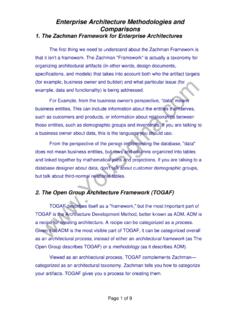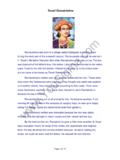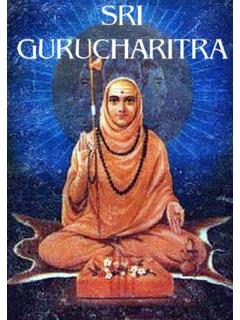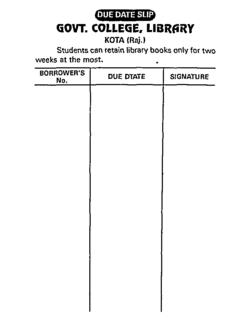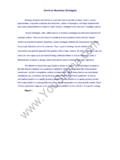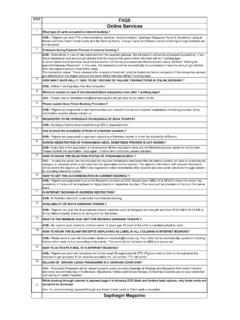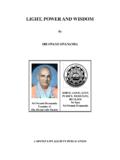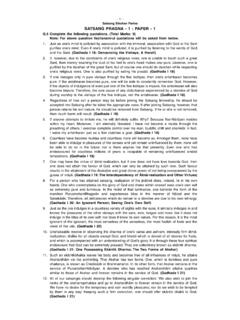Transcription of The Vaisheshika Darshana
1 The Vaisheshika DarshanaTranslation and Commentary by John WellsCopyright 2009 Chapter OneExposition ( ) atha now ata therefore dharmam dharma vy khy sy ma we shallexplain (This subject-verb construction does not seem authentic.) ( ) yata through which abhyudaya-ni reyasa-siddhi elevation, rising having nobetter, unsurpassed good accomplishment sa that dharma dharma, duty,destiny ( ) tat-vacan t (abl. because) (of) that exposition -mn yasya(gen. of) encompassing brought to mind, remembered, contemplated, (referringto Veda) pr m yam having the authority ( ) dharma-vi e a-pras t t(abl.)
2 Dharma this particular, this very engendered by dravya-gu a-karma-s m nya-vi e a-samav y n m (gen.) physical essential constituents action universal particular inherent pada-arth n m (gen. of) word(s) meanings,what is meant s dharmya-vaidharmy bhy m (inst. by way of, in terms of)consistency inconsistency tattva-j n t (abl. comes through) "essentialness",essence understanding ni reyasam unsurpassed good Now, therefore, we shall explain Dharma is that through which there is the accomplishment of rising tothe unsurpassed good. Because it is an exposition of that, it (this teaching)has the authority of Veda. Engendered by this very dharma, theunsurpassed good comes through understanding of the essence, in terms ofconsistency (with the dharma) vs.
3 Inconsistency (with the dharma), of what ismeant by the words "physical", "essential constituents", "action","universal", "particular", and "inherent". 2 The Vaisheshika DarshanaPhysicals, Essential Constituents, and Action ( ) p thiv earth pas waters (pl. of ap) (This will be translated in thesingular for simplicity.) tejas fire, light v yu air k am the ether k la timedik (di ) dimension tm individual self mana mind iti thus dravy i physicalthings ( ) r pa-rasa-gandha-spar form taste smell feelsa khy countings, reckonings parim ni measurings p thaktvamindividuality sa yoga-vibh gau conjunction disjunction paratva-aparatvepriority posteriority buddhaya discernings sukha-du khe happiness suffering icch -dve au desire aversion prayatn endeavors (The dual dvandvacompounds here (perhaps accusative), besides representing dichotomies ("vs.))
4 "),have a strong locative relationship with the transitive participles in the plural, sothe word "regarding" has been supplied.) ca and, along with gu essentialconstituents (like fibers of threads of strings of ropes, etc.) ( ) utk epa amup-casting avak epa am down-casting ku canam expansion pras ra amcontraction gamanam going iti thus karm i The physical things are: earth, water, fire, air, the ether; time anddimension; individual self and mind. Their essential constituents are:form, taste, smell, feel; countings; measurings; individuality; discerningsregarding priority vs. posteriority (and) conjunction vs. disjunction, alongwith endeavors regarding happiness vs. suffering (and) desire vs. aversion. actions are: up-casting vs.
5 Down-casting, expansion vs. contraction, existence of physical matter and of time and space, is commonlyacknowledged, as is the existence of the many individual people in this world whoperceive and think with their minds. This author, however, describes a creativeperception that is not commonly acknowledged, where the building blocks of thephysical things are known only by the perceiver. The source of this innerperception and creation, his true identity, is something the Darshana authors call"mahat" (great). It is intelligent (cit), which is discussed in , and it is oftenidentified with the ether because that is the foundation of its physical or "real" ( ) aspect. The ether is the abstract concept of an ethereal pervasive medium,Chapter One Exposition3not an independent physical substance.
6 It is rather the ambient substance of one'sconsciousness, within which one's temporal and dimensional reality first becomesperceptible. It is also associated with primal sound (see , and ). In this philosophy, the gross physical world arises from subtle sensations andtendencies called essential constituents (gu ), as a cord (gu a) is made of itsconstituent threads. The subtlest of them is feel or "touch" (spar a), which refers toall the various tactile sensations, inside and this foundation are created, cumulatively, the elements of "air" (breath),"fire" (light or heat radiation), "water", and "earth" (organic substance), in thatorder. Hearing and sound (speech) are always treated separately in the five sensations are associated with the body, but there is also an expansionof the microcosm of the body into the environment through the tendencies tomeasure reaching out or withdrawing in a radial way, grounding or rising in anaxial way, and rotating right or left in an angular way which tendencies definephysical dimension.
7 Then there is the tendency to count, by holding the old, thenchanging or progressing, then acknowledging the new (which then becomes theold), and repeating. Those three are the aspects of the three gu as of Sankhya:tamas, rajas, and sattva. Time would be defined here by this new foundation of thesensations combined with the tendencies of measuring and counting. Thus theauthor describes the knowledge of being an individual physical person, mindful ofa pre-existing world of objects, advancing through a continuum of dimension this scheme there is a serial aspect where the essential constituents arediscerned and ordered according to priority vs. posteriority, as well as a non-serialaspect where they are discerned in various relationships of conjunction with each other (see also SD ).
8 The "actions" (karmas) given here are all in relation to bodily impulses ratherthan activity in the external environment. "Up-casting" and "down-casting"represent the axial spectrum of falling by force of heaviness (gravity) vs. rising orcasting oneself up in opposition to it. Expansion and contraction are represented inthe body by respiration, heartbeat, peristalsis, grasping, letting go. etc., while inthe macrocosm there is condensation and dissolution of many kinds. The author's"going" (gamana) means creating any action in a forward direction, like the archermentioned in The difference between wilful action and the various kinds ofmovement in the environment is described in Chapter five on 'action'.4 The Vaisheshika Darshana interpolation interpolation Subjectivism Is Consistent with ( ) sat real anityam non-constant dravyavat (vati like, as) physicalk ryam effect k ra am cause s m nya-vi e avat (vati like, as) universal particular iti dravya-gu a-karma m (gen.)
9 Of, for) the physical essentialconstituents action avi e a not different, common ( ) dravya-gu ayo (loc. regarding, in) the physical essential constituents saj ti- rambhaka-tvaminstance originator being s dharmyam consistency ( is Appendix.) ( ) k rya-virodhi effect incompatible karma action( is commentary. See Appendix.) What is common for the physical, the essential constituents, and actionis: that they are cause (and) they are effect, as the universal and particularare; that they are non-constant and real, as the physical is. Theconsistency with the dharma (of understanding) in regard to the physical andthe essential constituents is their being (understood as) an instance and theoriginator of it (respectively), (but) karma is incompatible with this this statement the author has explained the first three principles ofVaisheshika named in sutra : the physical, the essential constituents, and as the Foundation Of the Universal and the ( ) k ra a-abh v t (abl.
10 Known by) cause absence k rya-abh va effect absence ( ) na not tu but k rya-abh v t (abl. known by) effect absence k ra a-abh va cause absence ( ) s m nya-vi e a universal particular iti called buddhi-apek am intellect Absence of effect is known by absence of a cause, but absence ofcause is not (necessarily) known by the absence of an effect. What iscalled here "universal and particular" is a consideration of intellect ..Chapter One Exposition5 Of the Physical, the Essential Constituents, and Action ( ) bh va existence anuv tte (gen. of) the following eva just so,thus hetu-tv t (abl. because) basis for knowing its being s m nyam universaleva thus ( ) dravyatvam physicalness gu atvam essential constituent-ness karmatvam actionness ca and s m ny ni universals vi e a particular ca and ( ) anyatra (loc.
